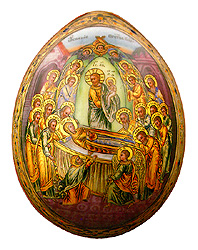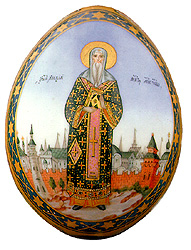 From time immemorial an egg has been the object of religious adoration. Practically, all highly developed nations are well aware of symbolic significance of an egg illustrating transition from non-existence to life; it-s a symbol of joy, happiness and sun which brings warmth and revival of the nature. In the ancient language of Egyptian hieroglyphs the determinative sign of an egg displays a certain potential, a life-giving seed, a mystery of being. From time immemorial an egg has been the object of religious adoration. Practically, all highly developed nations are well aware of symbolic significance of an egg illustrating transition from non-existence to life; it-s a symbol of joy, happiness and sun which brings warmth and revival of the nature. In the ancient language of Egyptian hieroglyphs the determinative sign of an egg displays a certain potential, a life-giving seed, a mystery of being.
The use of colored eggs also has deep roots going deep to the past centuries. This tradition was known in China, in Ancient Greece and in Rome. As for the Orthodox Easter traditi ons, the colored egg has always been one of the main symbols of Easter. There are two types of Easter eggs mostly used in Russia: "pisanki" v richly ornamented eggs of two, three or four colors, and "krashenki" v Easter eggs of one color, without any ornament. In compliance with ancient traditions Russians mark the celebration of Easter with presenting colored eggs to each other. ons, the colored egg has always been one of the main symbols of Easter. There are two types of Easter eggs mostly used in Russia: "pisanki" v richly ornamented eggs of two, three or four colors, and "krashenki" v Easter eggs of one color, without any ornament. In compliance with ancient traditions Russians mark the celebration of Easter with presenting colored eggs to each other.
This tradition was also very popular with the Russian ruling house; the colored eggs were presented to boyars and Russian nobility.
In addition to natural eggs, there were extensively used eggs made of different materials and richly ornamented. By the beginning of the 20th century Easter eggs making had turned to be an independent branch of Russ ian decorative and applied arts. ian decorative and applied arts.
A special place is occupied by porcelain eggs, which were specially ordered by the Russian Tsars at the Emperor Porcelain Manufacture. They are of high artistic value and perfection and are viewed at present as popular antique objects and Russian souvenirs.
|













 Culture and Art
Culture and Art  Arts and crafts
Arts and crafts